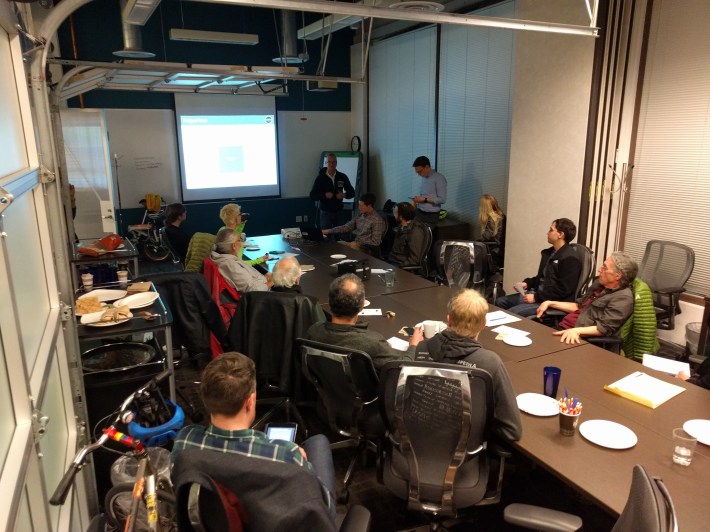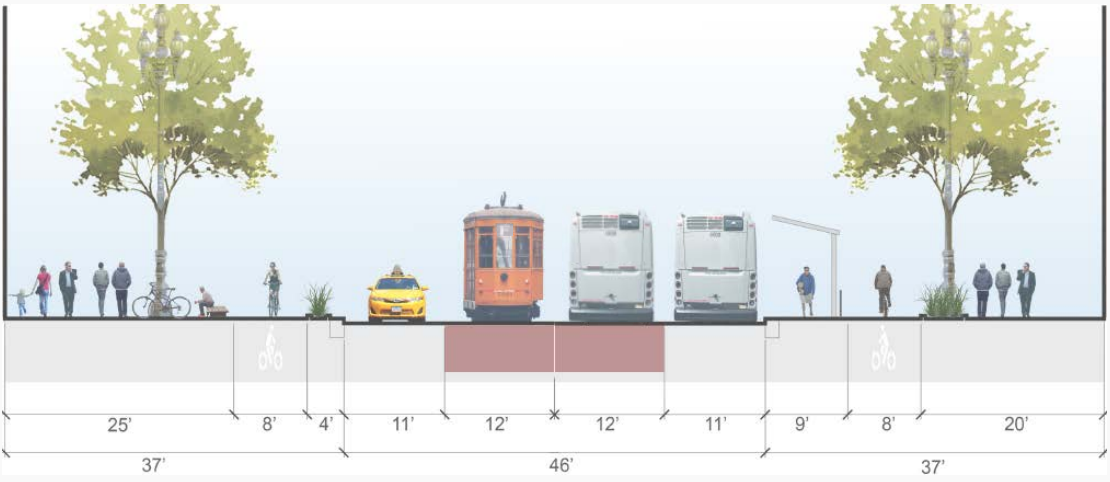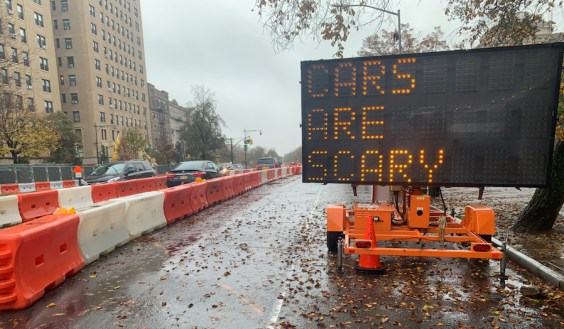Note: GJEL Accident Attorneys regularly sponsors coverage on Streetsblog San Francisco and Streetsblog California. Unless noted in the story, GJEL Accident Attorneys is not consulted for the content or editorial direction of the sponsored content.
Market Street hasn't been overhauled in 45 years, explained Simon Bertrang, Project Manager for the Better Market Street plan at San Francisco Public Works, during a presentation Monday evening to the San Francisco Transit Riders. "The streetcar tracks, traffic signals, and the sidewalks themselves are all in need of replacement, but when we put it back, we want to put back a better version of it."
And that better version, as safe and livable streets advocates celebrated last summer, will include protected bike lanes and a ban on private automobiles. Bertrang and the rest of his team, which includes representatives from SFMTA and five other city agencies, are now doing legally required environmental reviews.
"This is a $500 million project," said Bertrang. But, despite the high price tag, "We’re not gold-plating the street."
He explained that roughly half of that money is going to fixing and updating the un-glamorous fundamentals underneath the street--meaning sewers, water mains, utilities, and paving. They also need to replace all the Muni wires. "These investments are not optional."
Of course, most residents of San Francisco don't take much of an interest in how the sewers, water mains, power cables, etc. work (although people sure notice if they don't work).
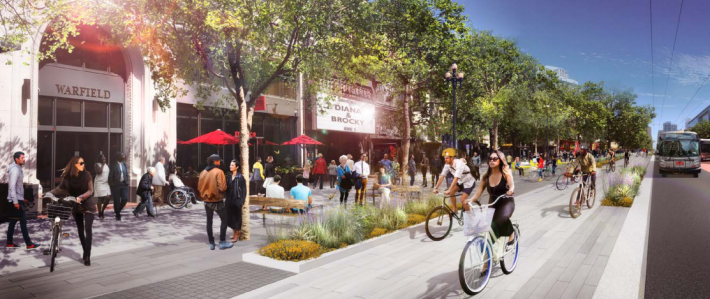
The rest of the money is going to improve the flow, safety and appearance of the street--in other words, the above-ground bits that people see and experience daily.
"It’s our busiest pedestrian street, busiest transit street... one in ten Muni riders are on Market Street every day," Bertrang added. "There are also thousands of bicycle commuters."
First, the bike lanes. The current design grew out of the city's now-infamous pilot of raised bike lanes between 12th and Gough. "We proposed a bike lane a few inches below sidewalk level but a few inches above the street," explained Bertrang. The idea was to make the raised bike lane mountable so paratransit could still drop riders off at curb level. But, predictably, everybody who drove a car or truck started doing the same thing. "SFMTA did surveys and the universal conclusion is it didn't do what we wanted it to do."
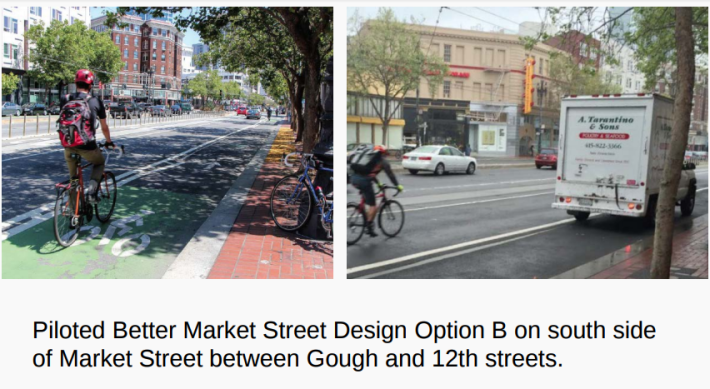
(Note from the editor: Maybe it's time to admit that drivers will never stay off of bike lanes voluntarily, anywhere in the universe, and to always design accordingly).
Thus started the design modification of putting the bike lane at sidewalk level, and making it eight feet wide so pairs of cyclists can ride side-by-side (or one rider can pass another) and protecting it with street furniture and planters so bikers and pedestrians have physical cues to stay out of each other's way (see two photos up). Importantly, it will be exceedingly difficult to park a car in the bike lane.
Making room for the new sidewalk-level bike lanes required "Shrinking transit and vehicle lanes... most of the space on Market Street will be given to people whether walking or on bicycles," said Bertrang.
This also means building two sets of bus boarding islands. The center lane will be for Rapid lines and their local pair (e.g. the 5 and the 5R). The curb lane lines will continue to make more frequent stops, with minor increases in their stop spacing to improve run times.

"The center lanes will go to Muni only, taxis will go to the curbside lanes, and commercial vehicles, and para-transit will still be allowed to use that curbside lane," explained Daniel Sheeter, Transportation Planner for SFMTA. The idea is to add some logic and consistency in bus services from Van Ness through to the waterfront, with longer, wider boarding islands. Of course, with private vehicles removed from the equation, transit will hopefully move a bit smoother (although there will still be those cabs, delivery vehicles and para-transit vans to deal with).
"The Rapid Stations will basically align with the subway stations," explained Michael Rhodes, Muni Forward Transit Planner. "The benefit of doing this is for substantial peak-hour transit improvements for the center lane of several minutes." He said the agency will also time the traffic signals to favor the movement of the Rapid buses.
There will also be some improvements to the F-Market and Wharves streetcar service (although nothing as radical as adding modern streetcars with higher capacity). Rhodes explained that the streetcar service is actually fairly well-used between Fisherman's Wharf and the start of Market Street, but then drops off significantly at Powell. SFMTA has proposed a turn-around loop so some F-Market trains can return to the Marina rather than continuing all the way to Castro, to allow for additional daytime service between Powell and Fisherman’s Wharf.
To accomplish this, the agency plans to build a turn-around as seen below. This will also give "an option when there’s a mechanical issue," said Rhodes. "It will help with reliability with the F." In other words, if a train breaks down on Market Street, they'll have another place to get it out of the way.
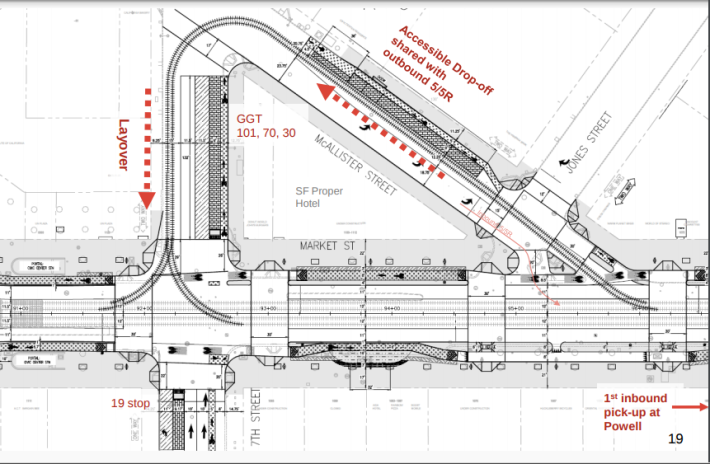
The city hopes to start construction in 2020. The first outreach meetings on this modified plan will be held on March 10 and 14. For more details, check out the Better Market Street project web page.
